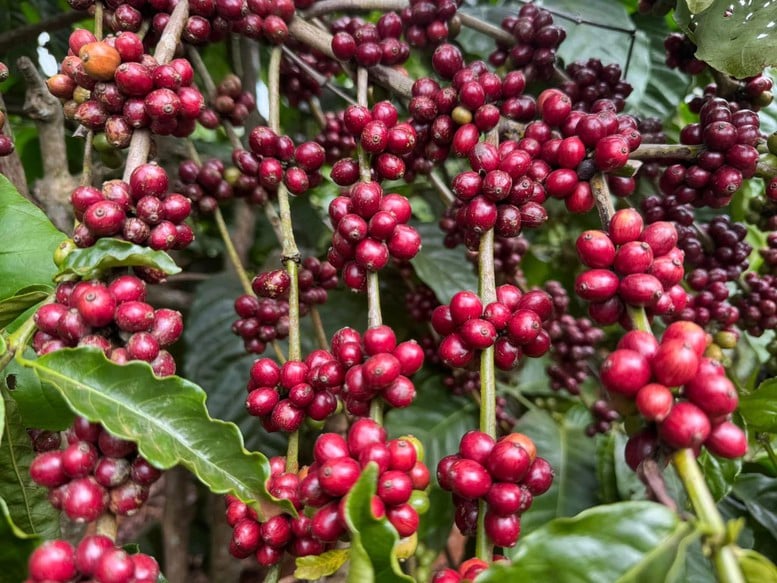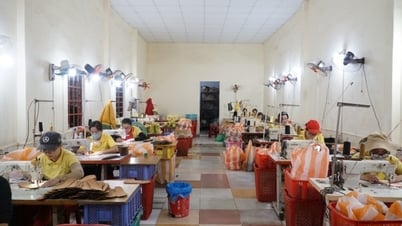
Coffee exports in the first quarter of 2025 decreased by 12.9% in volume but increased by 49.5% in value - Photo: VGP/Do Huong
According to estimates from the Ministry of Agriculture and Environment , the export turnover of agricultural and forestry products in March 2025 reached 6.14 billion USD, bringing the total export turnover in the first 3 months of the year to 15.72 billion USD. Compared to the same period in 2024, the export value increased by 13.1%, showing the recovery and stable growth of the industry. In particular, the main commodity groups recorded the following growth rates: agricultural products reached 8.53 billion USD (up 12.2%), livestock reached 131.3 million USD (up 18.5%), aquatic products reached 2.29 billion USD (up 18.1%), forestry products reached 4.21 billion USD (up 11.2%), production inputs reached 549.5 million USD (up 19.6%), and salt reached 2.3 million USD (up 2.4 times).
By market, Asia continued to be the largest export region, accounting for 42% of the market share, followed by the Americas (22.5%) and Europe (16.6%). Compared to the same period in 2024, the export value to Asia increased by 2%, the Americas increased by 15.7%, Europe increased sharply by 37.8%, Africa increased by 2.1 times, and Oceania increased slightly by 0.8%. Among specific markets, the United States led with a market share of 20.2%, achieving an export value increase of 13.5%. China and Japan accounted for 17.3% and 7.7% of the market share, respectively, with growth rates of 3.6% and 26%, respectively.
Exporting many key products: Increasing value, decreasing volume
According to statistics from the Ministry of Agriculture and Environment, many product lines have brought in much more positive commercial value despite a decrease in export volume. This shows that the value of products has been improved in quality and meets the needs of the international market.
In the first quarter of 2025, coffee exports reached 509,500 tons, down 12.9% in volume but up sharply 49.5% in value, reaching 2.88 billion USD. The average export price of coffee reached 5,656 USD/ton, up 71.7% over the same period in 2024, thanks to the strong increase in demand for high-quality coffee. Germany, Italy and Japan were the three largest markets, with export value increasing by 79.3%, 31.9% and 56.1% respectively. The Polish market recorded the strongest increase (3.1 times), while Indonesia decreased by 37.5%.
Rubber exports reached 396,100 tons, down 4.4% in volume but up 26.1% in value, reaching 765.8 million USD. The average rubber price reached 1,933.3 USD/ton, up 31.9%. China was the largest market, accounting for 73.7% of the market share, with export value increasing by 21.9%. The Indonesian market increased sharply by 3.1 times, while India decreased by 27.5%. Malaysia recorded the highest increase (8.3 times), while Germany decreased the most (29.9%).
Tea exports reached 27.3 thousand tons, up 3% in volume and 2.7% in value, reaching 44.4 million USD. The average tea price reached 1,622.4 USD/ton, down slightly by 0.2%. Pakistan, Taiwan and Russia were the three largest markets, with export value to Russia increasing by 33.5%, while Pakistan and Taiwan decreased by 11.8% and 5.7% respectively. The Philippines increased the most (4.1 times), while Poland decreased the most (67.6%).
Cashew nut exports reached 121.4 thousand tons, down 19.3% in volume but up 4.3% in value, reaching 841.1 million USD. The average price reached 6,929.2 USD/ton, up 29.1%. The United States, the Netherlands and China were the three largest markets, with the Netherlands increasing by 43.5%, while the United States and China decreased by 14.5% and 50% respectively. France increased the most (46.1%).
Pepper exports reached 47.3 thousand tons, down 16.7% in volume but up 37.3% in value, reaching 323.6 million USD. The average price reached 6,845.4 USD/ton, up 64.9%. The United States, Germany and India were the three largest markets, with Germany increasing the most (2.4 times).
Seafood export value reached 2.29 billion USD, up 18.1%. China, Japan and the United States were the three largest markets, with China increasing the most (75.9%). Taiwan decreased by 2.7%.
Wood export value reached 3.95 billion USD, up 11.6%. The US accounted for 53.1% of the market share, with value increasing by 9.5%. India increased the most (95.9%), while the Netherlands decreased by 45.1%.
The trade balance of the agro-forestry and fisheries sector in the first quarter of 2025 reached a surplus of 4.4 billion USD, up 13.1% over the same period in 2024. The forestry products group had a surplus of 3.54 billion USD (up 9.1%), the aquatic products had a surplus of 1.51 billion USD (up 14.1%), and the agricultural products had a surplus of 1.48 billion USD (up 16.9%). Meanwhile, the production input group had a deficit of 1.21 billion USD, livestock products had a deficit of 905.7 million USD, and salt had a deficit of 4.6 million USD. The commodities with the highest surplus included wood (3.29 billion USD), coffee (2.79 billion USD), and shrimp (792.6 million USD).
According to Deputy Minister of Agriculture and Environment Phung Duc Tien, changes in tax policies and requirements of international markets will impact the agricultural export market in the near future. In particular, the US market is applying new tariff measures on many items, including agricultural products.
However, Deputy Minister Tien also emphasized that to cope with these changes, Vietnam has made careful and flexible preparations, including proactively developing response scenarios and closely cooperating with relevant ministries and sectors. At the same time, specialized agencies have also worked with international partners to minimize negative impacts and find the most effective solutions for Vietnam's agricultural sector.
Do Huong
Source: https://baochinhphu.vn/xuat-khau-nong-lam-thuy-san-quy-i-dat-thang-du-44-ty-usd-102250402083934971.htm


![[Photo] Prime Minister Pham Minh Chinh chairs meeting on science and technology development](https://vphoto.vietnam.vn/thumb/1200x675/vietnam/resource/IMAGE/2025/5/17/ae80dd74c384439789b12013c738a045)
![[Photo] More than 17,000 candidates participate in the 2025 SPT Competency Assessment Test of Hanoi National University of Education](https://vphoto.vietnam.vn/thumb/1200x675/vietnam/resource/IMAGE/2025/5/17/e538d9a1636c407cbb211b314e6303fd)


![[Photo] Readers line up to visit the photo exhibition and receive a special publication commemorating the 135th birthday of President Ho Chi Minh at Nhan Dan Newspaper](https://vphoto.vietnam.vn/thumb/1200x675/vietnam/resource/IMAGE/2025/5/17/85b3197fc6bd43e6a9ee4db15101005b)

















![[Photo] Nearly 3,000 students moved by stories about soldiers](https://vphoto.vietnam.vn/thumb/1200x675/vietnam/resource/IMAGE/2025/5/17/21da57c8241e42438b423eaa37215e0e)







































































Comment (0)